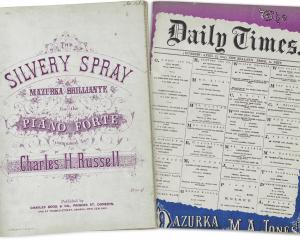How did a feathered cape belonging to the last Queen of the Hawaiian Islands end up in Otago Museum? asks Jamie Metzger.
Hundreds of years ago, tropical honeycreeper birds traversed the skies of Hawaii. Held in high regard for their link to the heavenly realm, their feathers were used to create brilliant capes, or 'ahu 'ula.
The 'ahu 'ula on display in the Pacific Cultures Gallery at Otago Museum belonged to Queen Lili'uokalani, the last ruling monarch of the Hawaiian Islands before American colonisation.
She is best known for her composition of the love song Aloha Oe.
Feathered capes were made to identify and protect their wearers, and were reserved exclusively for royalty and high chiefs.
While each cape is made up of simple geometrical elements, no two are the same.
Their distinctive designs make statements about the "aumakua'' (genealogy) and mana (spiritual power) of the wearer.
In the 17th and 18th centuries the capes were used to secure political alliances, worn on the battlefield and seized as spoils of war.
In the 19th and 20th centuries, featherwork was traded with and given to visitors from overseas as a symbol of Hawaiian craftsmanship and culture.
The fragmented story of how Queen Lili'uokalani's 'ahu 'ula came into Otago Museum's collection
involved many people.
The cape was originally in the collection of the Elgin Museum, in Scotland, donated by Caroline Stuart, Countess Dowager of Seafield, in 1897.
How the countess came to be in the possession of the cape originally still remains a mystery.
The cape then fell into the hands of keen Pacific ethnographic collector Kenneth Athol Webster, an expatriate New Zealander living in London.
Otago Museum then had the opportunity to purchase the cloak from Webster for £140 in 1955.
The cape is built upon a netted backing made from olona fibre.
The feathers were attached in bundles while a prayer was recited, which was considered just as powerful as the fibre itself.
Thousands of feathers are required for a these types of capes, only a few plucked from a bird at a time before it was set free.
The workmanship and skill that went into crafting 'ahu 'ula took years.
The vivid colours of the yellow and black feathers come from the ‘o‘o bird, while the ‘i‘iwi bird supplied the red.
These birds once flew the twisting coast lines and tallest mountains of Hawaii, but their demand has led to the ‘o‘o's extinction and ‘i‘iwi's dwindling numbers, making the capes even more special.
Their colouring is symbolic. Red is associated with Ku, the Hawaiian god of warfare, and yellow with Kane, the god of life and creation.
While red was associated with chiefs and gods, yellow became the most prized colour, due to the scarcity of the feathers.
Even in primarily yellow cloaks, red feathers can still be found hidden in layers underneath, protecting the wearer with their sacred power.
- Jamie Metzger is the collection officer, humanities, at Otago Museum.

![‘‘Neil’s Dandelion Coffee’’. [1910s-1930s?]. EPH-0179-HD-A/167, EPHEMERA COLLECTION, HOCKEN...](https://www.odt.co.nz/sites/default/files/styles/odt_landscape_small_related_stories/public/slideshow/node-3436487/2025/09/neils_dandelion_coffee.jpg?itok=fL42xLQ3)










